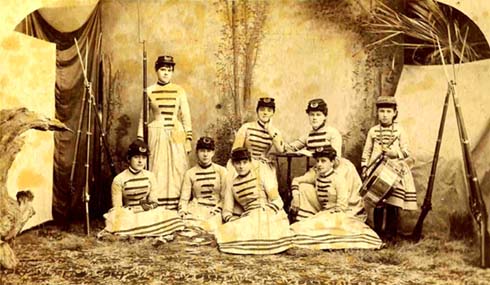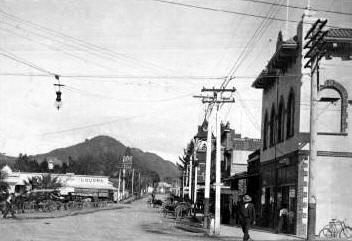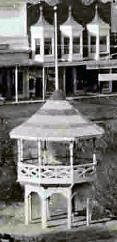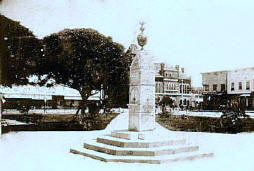|
|
|||||||||||||||||||||||||
It all started with a pair of fading sepia photographs I came across occasionally during searches in the archives. They intrigued me because one showed a group of prim young ladies in the bustled, tight-fitting, bust bunching street costume of the 1880's. The other showed the same girls in military uniforms, solemnly posed with very real looking firearms. On the back of both photographs was written, "Albanian Literary and Military Society".
Albanians? In Healdsburg? These ladies looked like WASPs. Literary and military society? That seemed a queer combination. What were these young ladies up to?
Unfortunately the club formed in the early 1880's, a time period for which there are no complete set of local newspapers. That gap in Healdsburg's historical record has caused many problems for local research, and threatened to leave the young "Albanians" forever a mystery.
Having developed an affection for the oddball group, I reproduced the photos in a newsletter. The first part of the puzzle came together several years later when Addie Marie Meyer of Healdsburg was looking through an old family scrapbook. She came across a pair of undated newspaper articles about the club. Having an excellent memory, Mrs. Meyer recalled my original ad. The first clipping read:
It may seem unremarkable to modern readers, but at the time many believed that physical exercise was unladylike, even harmful to the female anatomy, and the sight of a local girls in military drill must have horrified some. The Albanians sparked interest as far away as San Francisco, where the Alta California newspaper carried the following undated information:
Rid of HoopsAlthough the articles did not indicate what this all had to do with Albania, they did shed light on the mysterious club and placed it in historical perspective. Many think that the women's rights movement, including the fight for the vote, is a Twentieth Century phenomenon. The struggle for equal rights for women extends much farther, even to the Civil War. In the 1880's, however, there were very visible changes, both in women's attitudes and dress.
In the 1880's ladies got rid of the huge hoop skirts that had incapacitated them since the 1850's. They began to wear long full skirts with matching jackets, tailored very much like a man's suit. Except for the weird aberration known as the bustle, and the ever-present corset that helped contain them beneath the taut silk and linen of their jackets, it was much easier for women to move about in this new full skirt devoid of barrel structure.
A group of Healdsburg girls was obviously in the forefront of this new attitude for women, the revolutionary idea that girls could exercise without damaging their psyches, their bodies, or their sterling reputations. Not only did they have the originality to link the concept of books to bayonets, they got up and exercised, possibly even sweating, in public, on the stage of Truitt's Theater in downtown Healdsburg in the 1880's. But as it turned out, this was only their political boot camp.
Taking Up Political ArmsIt was not until the photos were published in the local newspaper that the largest puzzle pieces fell into place. Healdsburg native, Carmel Byington Bottini, recognized her mother, Katherine Ryan Byington, and her aunt, Mary Ryan Swisher, in the photographs. Although she could not tell us why the group chose the Albanians, she did recall that her mother said the group met at Truitt’s Theater. Most importantly, she remembered her mother saying that most of these girls evolved into another group called the Ladies Improvement Club.
The Ladies Improvement Club of Healdsburg mustered in November 1899. By the spring of 1900 they were absolutely the most controversial club in town. It would appear that these teenage revolutionaries, upon reaching their thirties, and perhaps now with their children out of diapers, took up political arms to improve their community. In so doing they challenged the male political establishment, and ignited a firestorm of controversy
It all began innocently enough, holding fundraising bazaars and electing the obligatory annual officers. By January 1900, under the leadership of Mrs. W.H. Barnes, Mrs. E. Hamilton, Mrs. J. McDonough, and Mrs. Wolf Rosenberg, the group had already accomplished the lettering and installation of the first street signs, and had all of the electrical poles painted (maybe white?).
Even before they became an official club the women apparently played a significant role in the great fight for publicly-owned electricity and water in Healdsburg, and this battle might have given them a taste for politics.
Ladies Take Reins of Municipal CoachA glowing letter about the Ladies Improvement Club from a Healdsburg correspondent was printed in a regional newspaper and quoted in the Tribune on April 5, 1900:
“Dissatisfied with the progress of the town under masculine rule, the ladies gently but firmly took possession of the reins and are now driving the municipal coach in their own sweet way. And man – slow going Silurian man! – well, he has been shelved, forced aside, and made to take a back seat while his wife and his sisters and his cousins and his aunts give him practical lessons in making a city clean, attractive, and beautiful.
There is an organization of course. It is called the Ladies Improvement club of Healdsburg and it was formed in August of last year. Since that time – in the short space of seven months – this is what the club has accomplished:
All these improvements had been discussed for years – by the men...as desirable...in the misty future. It remained for the women to make them realities.”
The editor of the Healdsburg Tribune reprinted portions of this letter without trying to conceal his sarcasm and hostility towards the purposeful “ladies”. He seemed to doubt that the club should take credit for the list.
Lady Imps Ignite
Firestorm Yet there was one thing that everyone in Healdsburg was ready to credit, or blame on, the Ladies Improvement Club - that drinking fountain right in the middle of the Plaza. Since the early 1880’s the town had erected a seasonal bandstand in the center of the Plaza. The Saturday night band concerts that focused on this structure had become famous throughout the County. In 1897 the town invested in an attractive circular gazebo to cover the old bandstand and to draw more visitors. Perhaps it was the popularity of the bandstand for socializing and the ever-increasing fame of the Saturday night concerts, that led to its controversial downfall only three years later.
Evening concerts inevitably included the consumption of alcohol. One aspect of the progressive, improvement–oriented spirit that seized some segments of the nation at the turn-of-the-last-century included the Temperance Movement to ban alcohol. Following the lead of Temperance Leagues throughout California, Healdsburg’s progressive group, the Ladies Improvement Club, received permission from the City Trustees to replace the bandstand with a central drinking fountain. Many cities installed such fountains as a symbol of their determination to outlaw stronger refreshments.
They might have placed the fountain anywhere on the Plaza, but the “Lady Imps”, as they were now tauntingly labeled in the press, had aimed their political clout directly at the bandstand and its unsavory influences. The proposed removal of the town’s favorite gathering place ignited a firestorm of controversy. The City Trustees, caught in the middle of the debate, became mired in indecision.
Indecent Graffiti When a citizen’s petition began to circulate to save the bandstand, the Ladies Improvement Club, intent upon their Higher Purpose, had the thing hurriedly axed down. This rash action started a year long battle between community factions, fought out on the Plaza, in the newspapers, and at City Trustee meetings.
On April 12, 1900 the Tribune reported that a group of young people had
played a hoax on the Lady Imps. In the dark of night they erected a fake
“marble” monument in the center of the Plaza, built out of muslin stretched over
a wooden frame. The newspaper fussed over “indecent” inscriptions that
were scrawled upon the thing, stating, “The sentiments expressed on the monument
were worthy of Barbary Coast hoodlums.” With the help of an attorney, the Ladies finally prevailed over all, and dedicated that gravestone-like drinking fountain on May 1, 1901. Not completely defeated, however, the rest of the community immediately erected a temporary bandstand next to the fountain, succeeded by a permanent one donated by local businessmen in 1915.
Random Acts of Beautification This “triumph” seems to have been the zenith of the group’s combative political activism. They went on to perform such random, and to some masculine minds perhaps senseless, acts of beautification as the lining of the highway from Healdsburg to Lytton Springs with trees in 1904. By 1912 they had adopted the more liberated title, “Women’s Improvement Club”, but their projects became less ambitious, if no less worthy. Now they concentrated on raising money to aid the Fire Department, the Chamber of Commerce, or the local schools.
They did manage to incorporate with stockholders in 1912, and to erect a clubhouse of their own the next year on Center Street, between North and Piper. Yet by 1918 the little used building was taken over by the Red Cross. The latest record found on the group was a notice of a meeting held after the Red Cross departed in September 1919. That meeting was probably their last.
By this time most of the charter members, the firebrand Albanian Literary and Military Society, would have been in their early to mid-fifties. The sword of their militarism may have been blunted by age or by the triumph of the nation in garnering the vote for women. Women’s suffrage was assured by the date of that last meeting, although it was not official until 1920. It was time, they may have hoped, for their “dancing daughters” to take up the good fight. And then, of course, came the Roaring Twenties |
|||||||||||||||||||||||||



